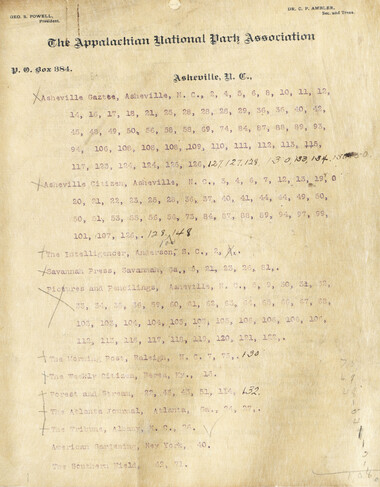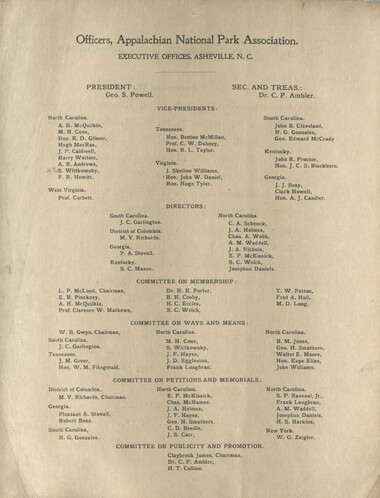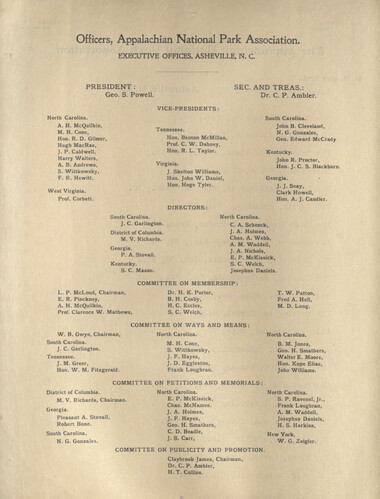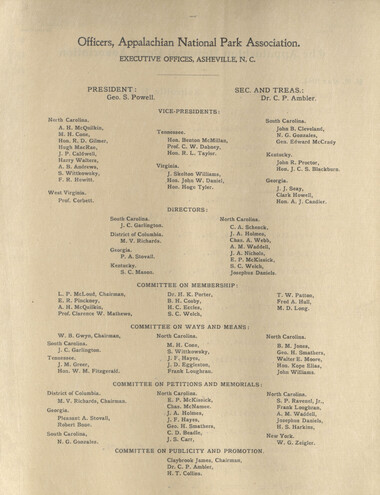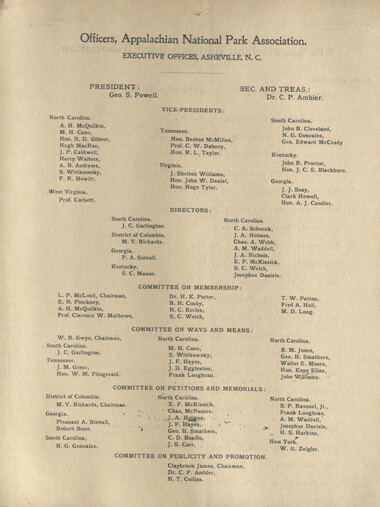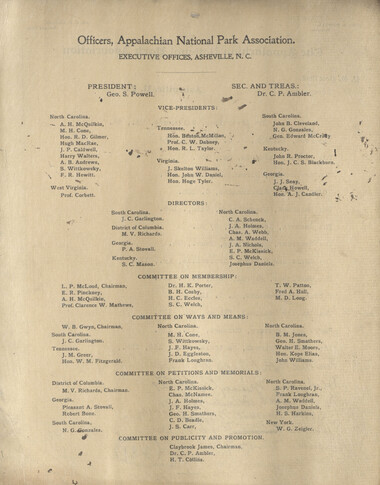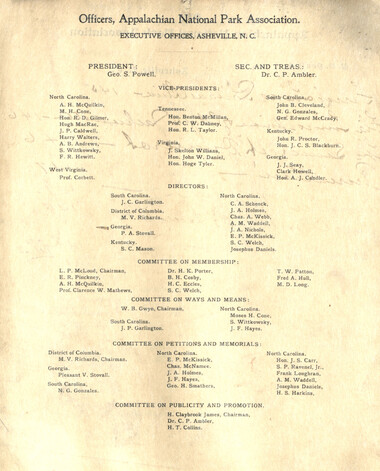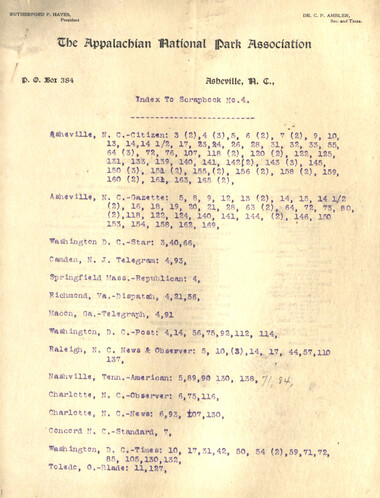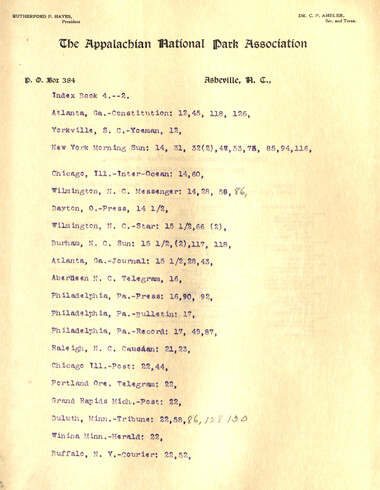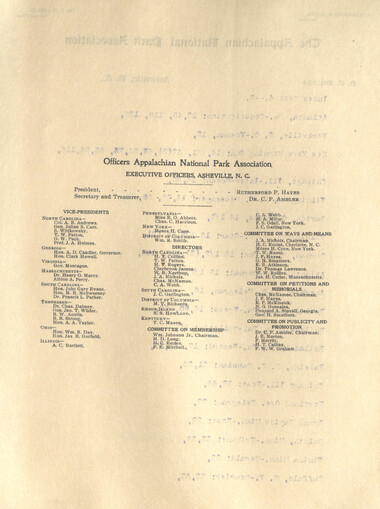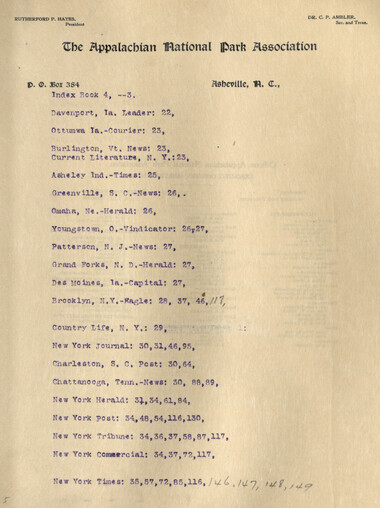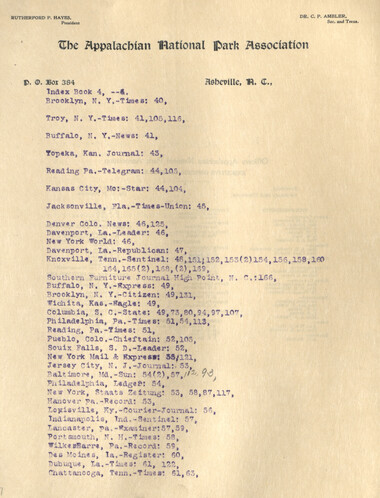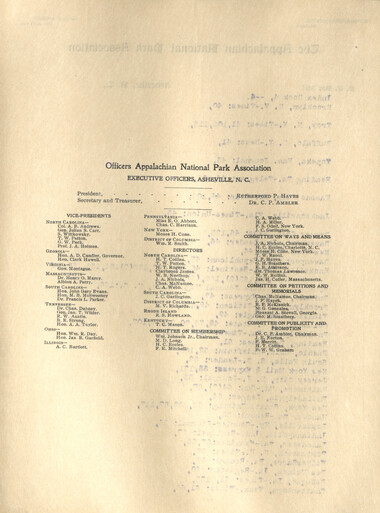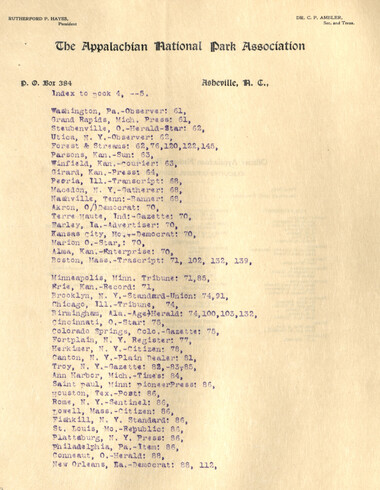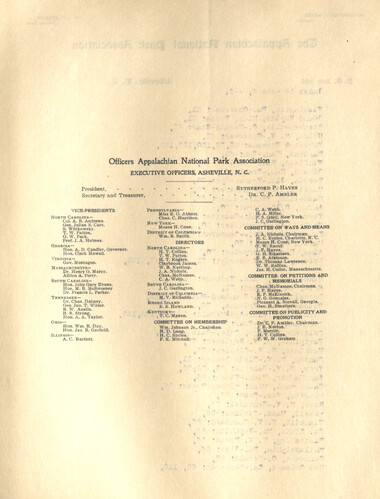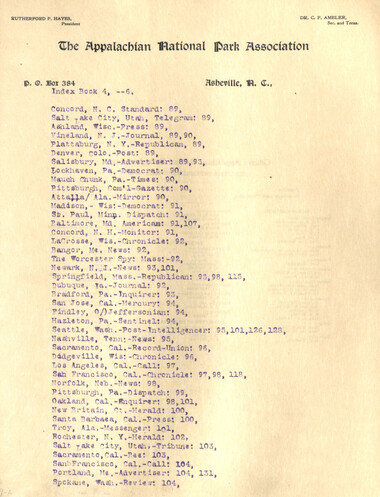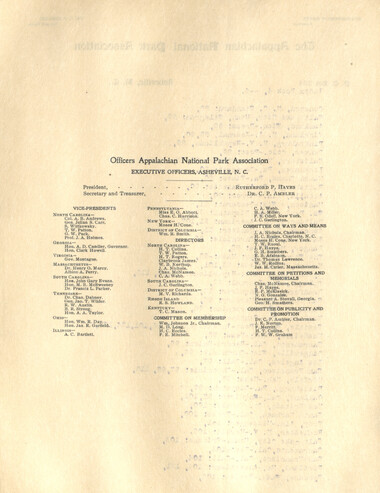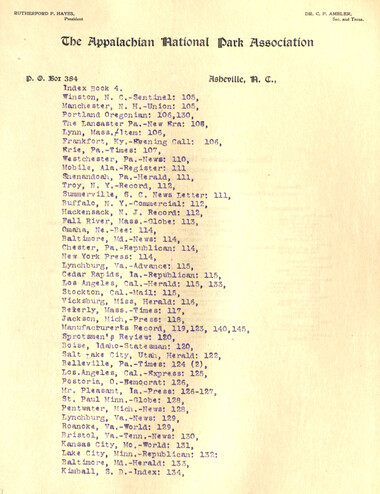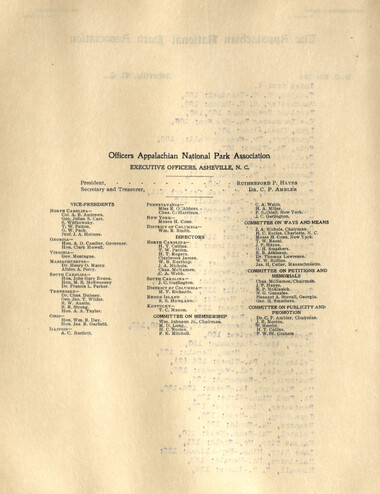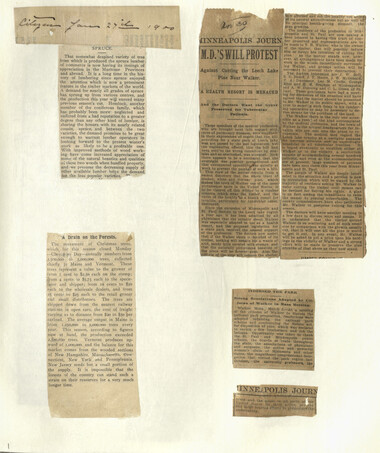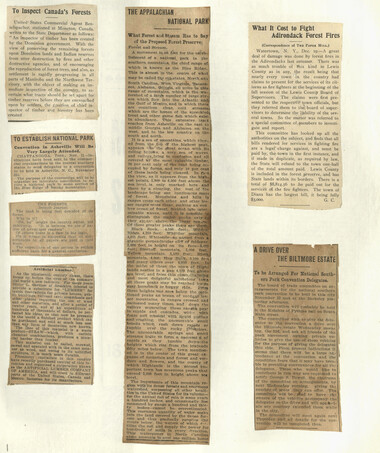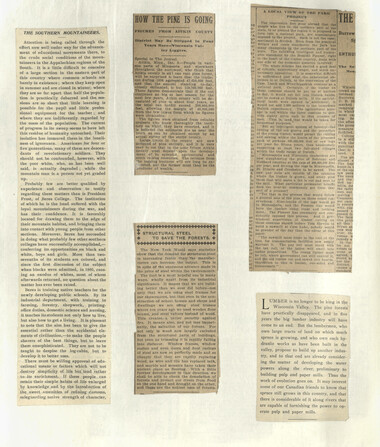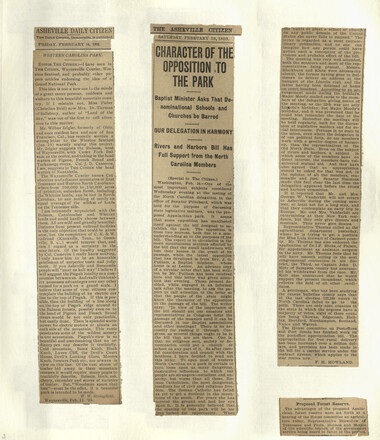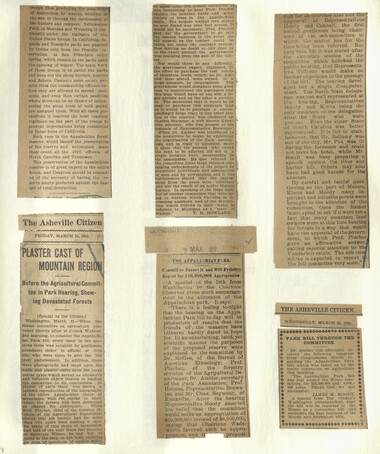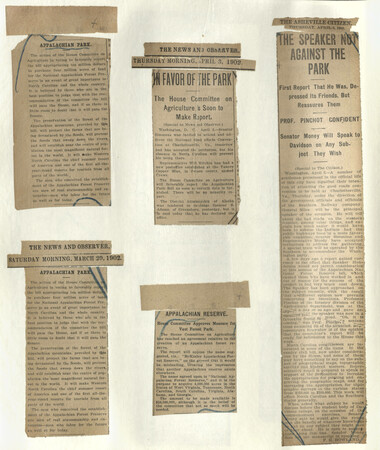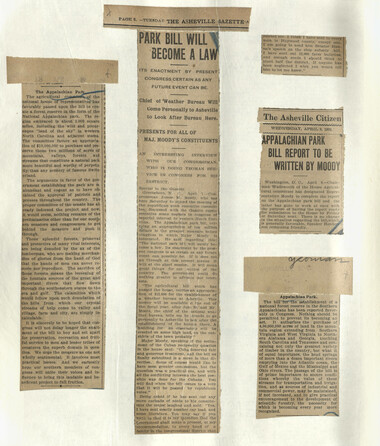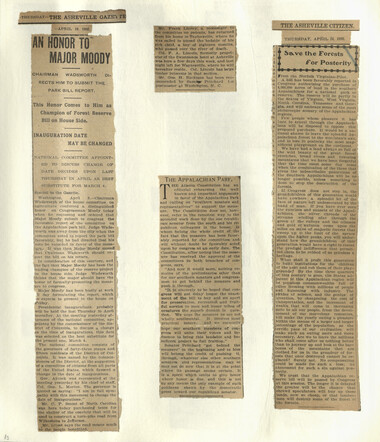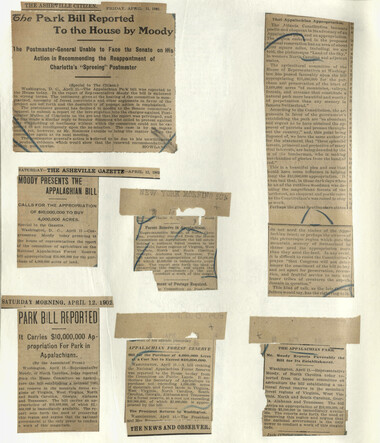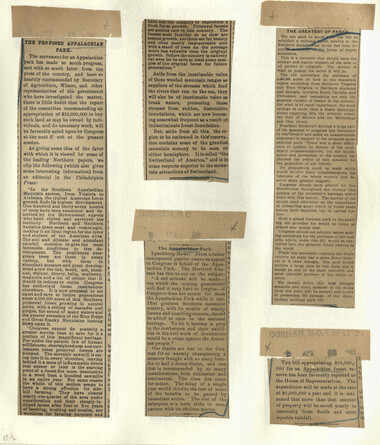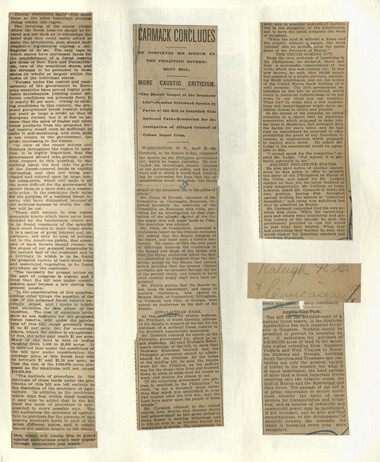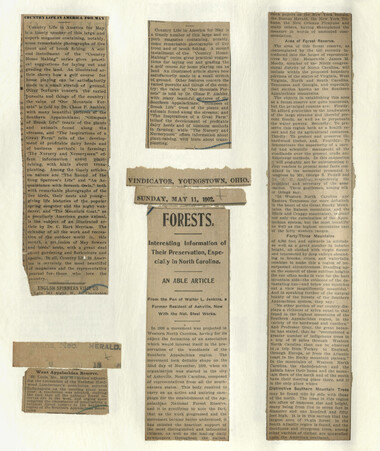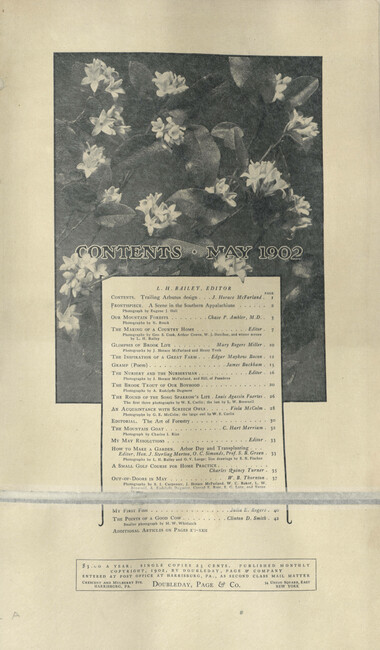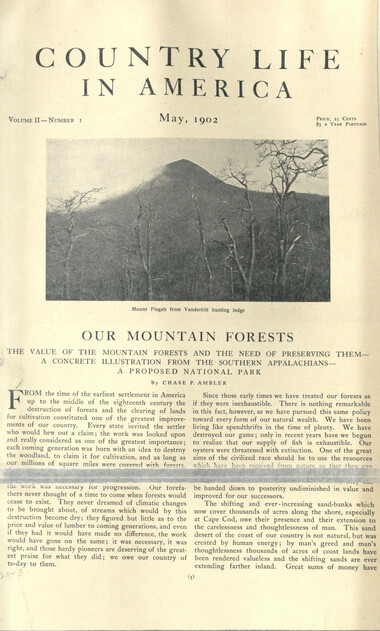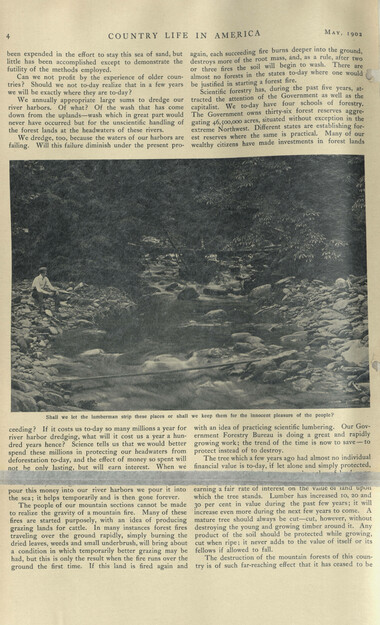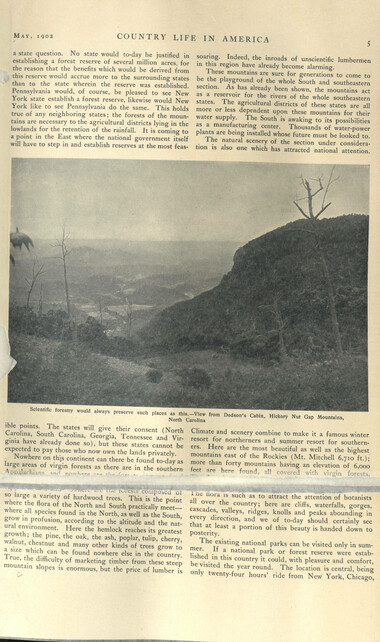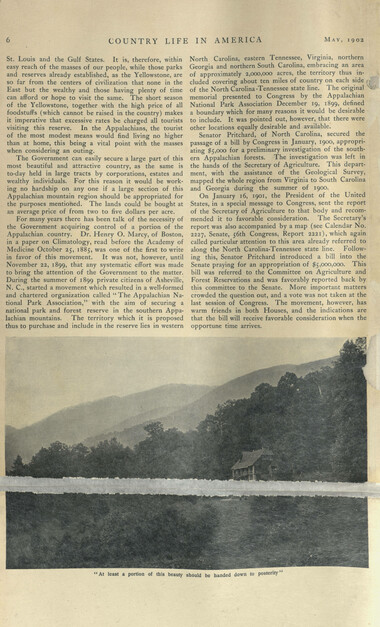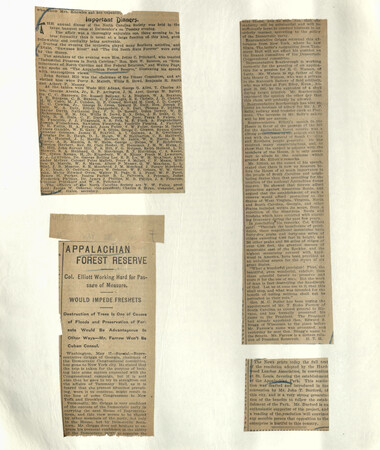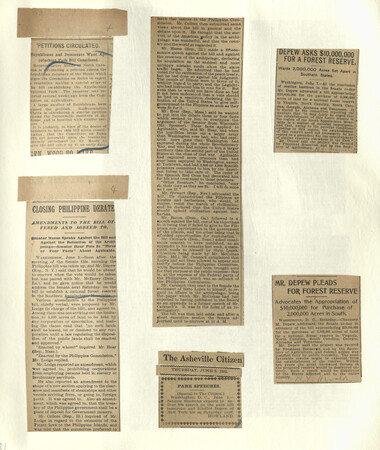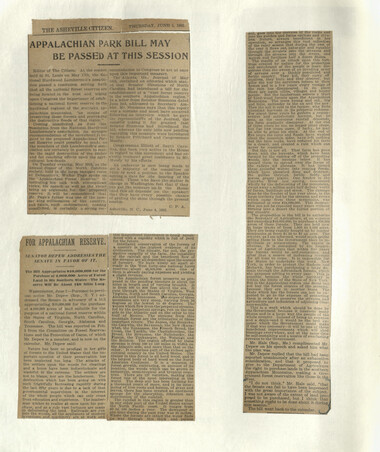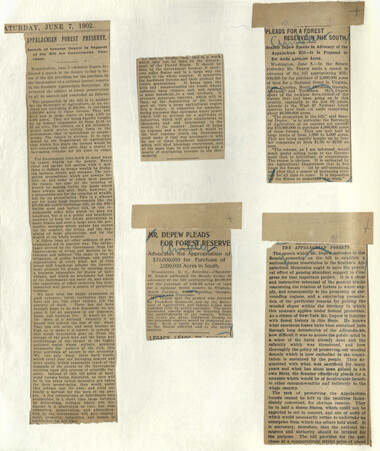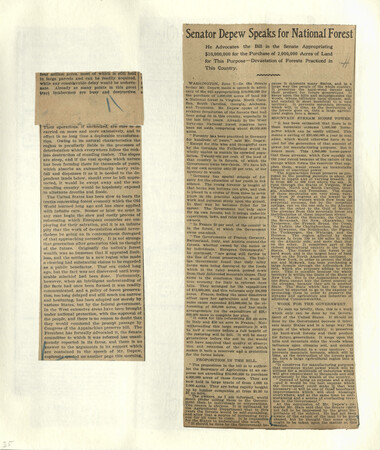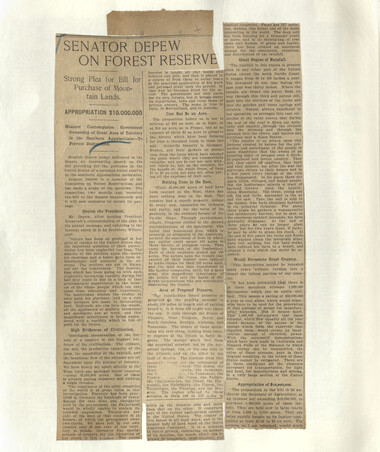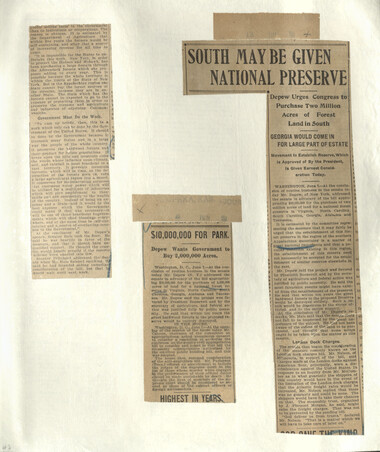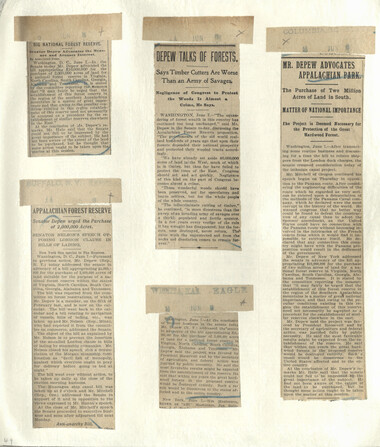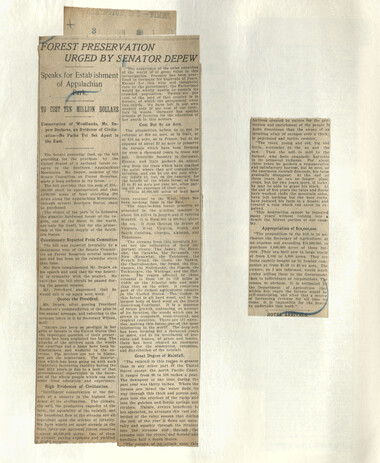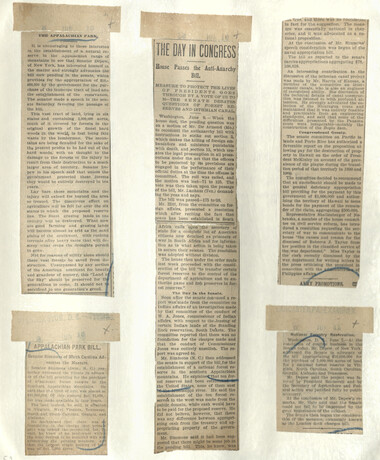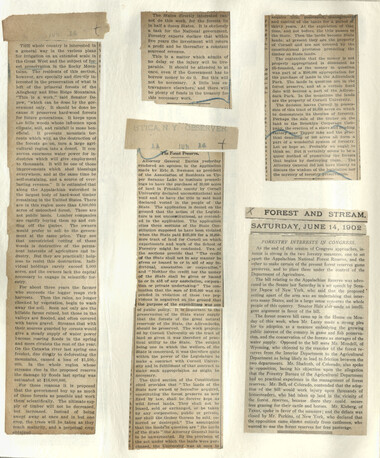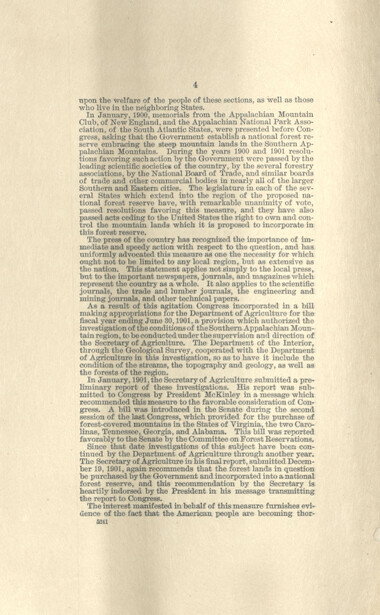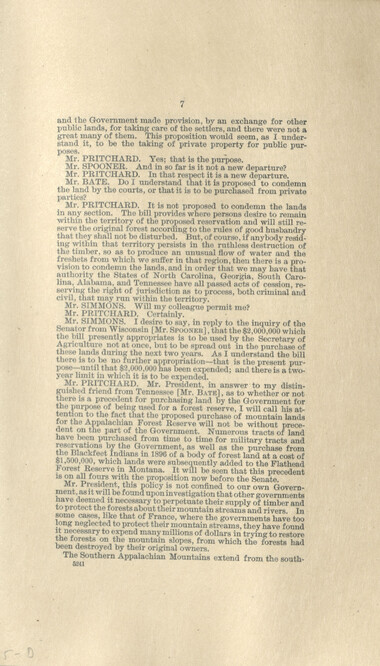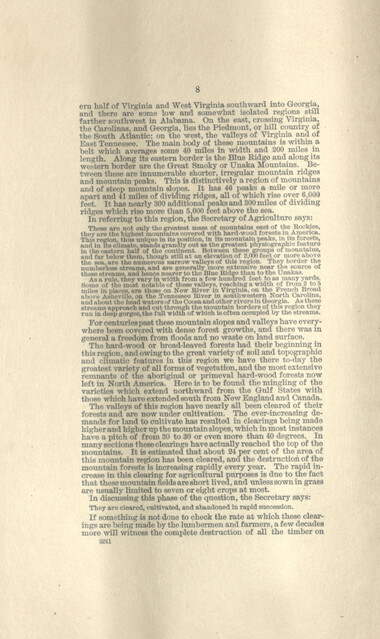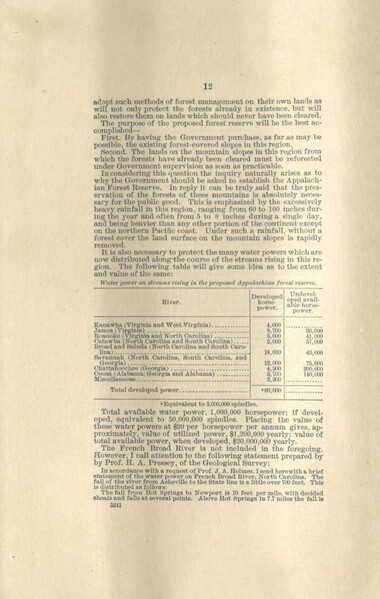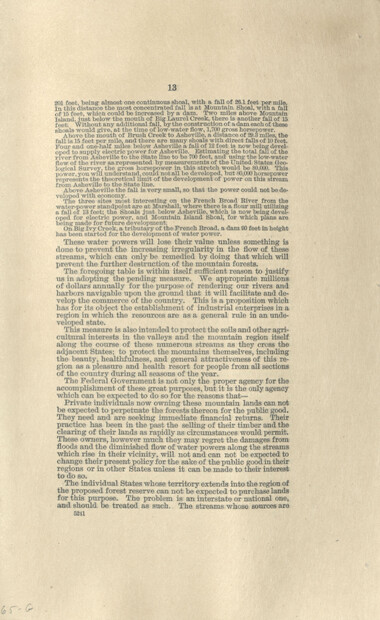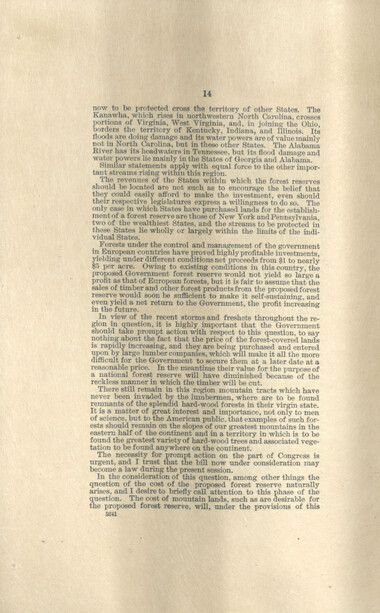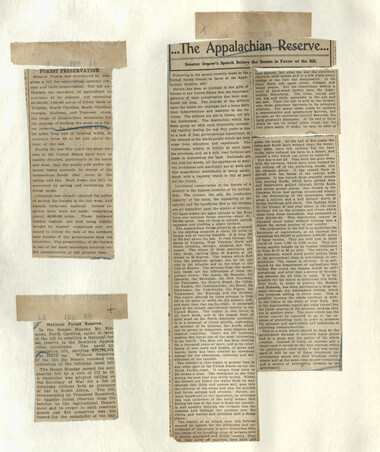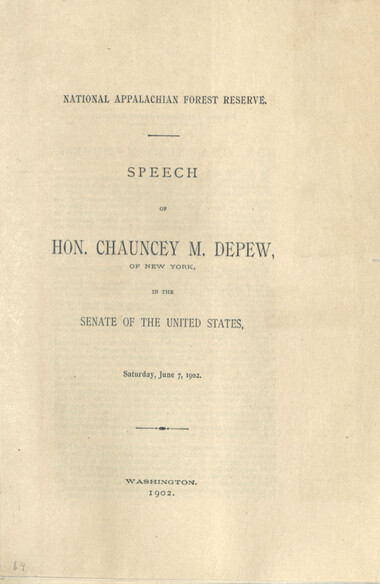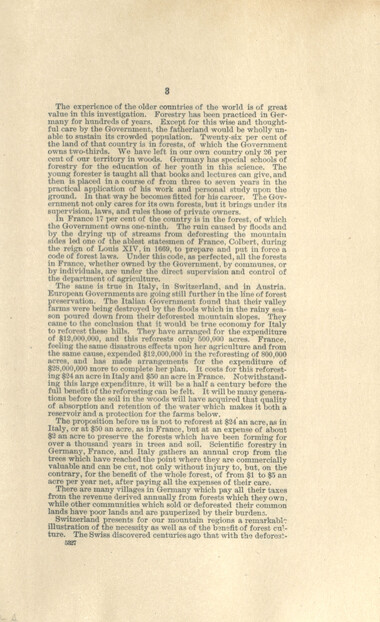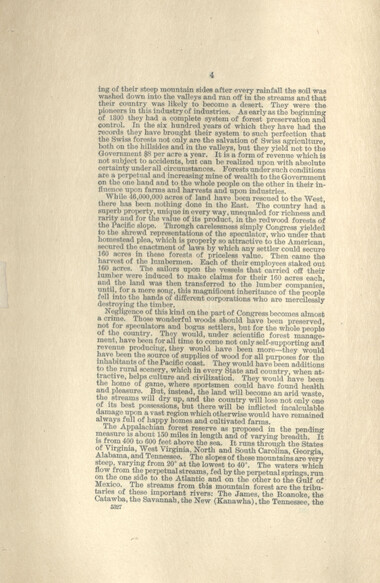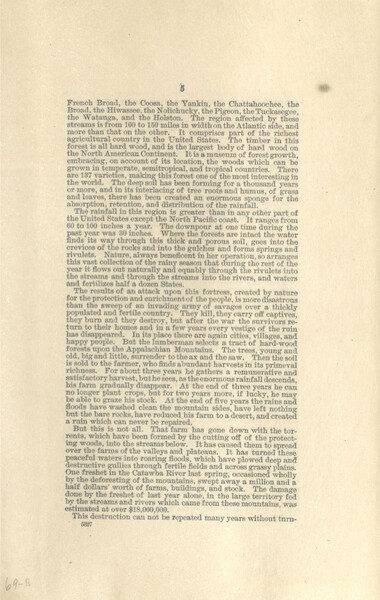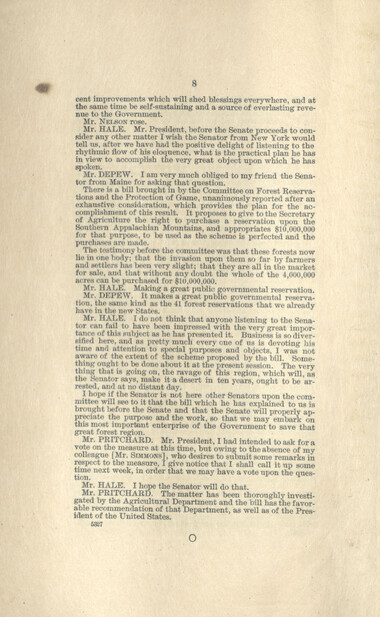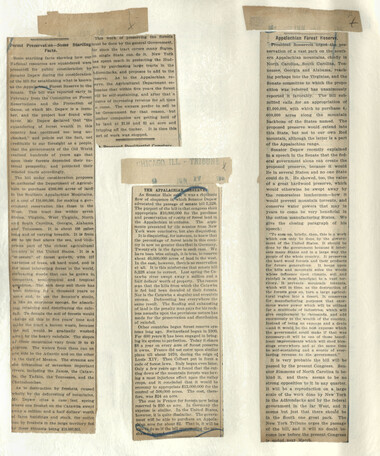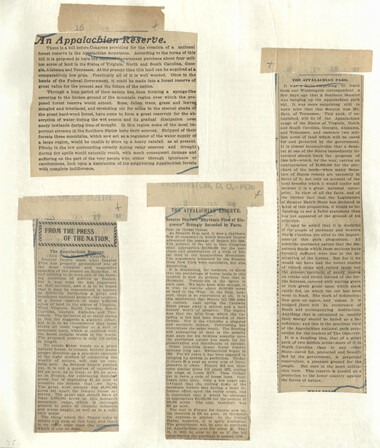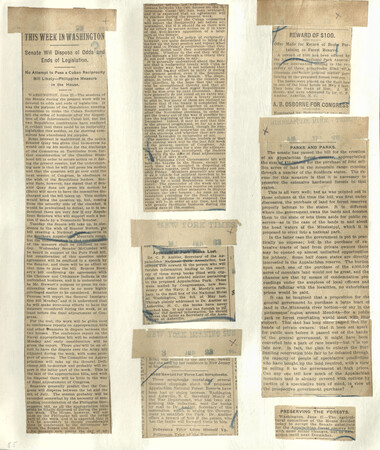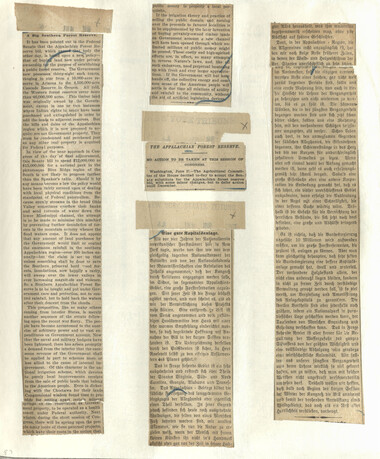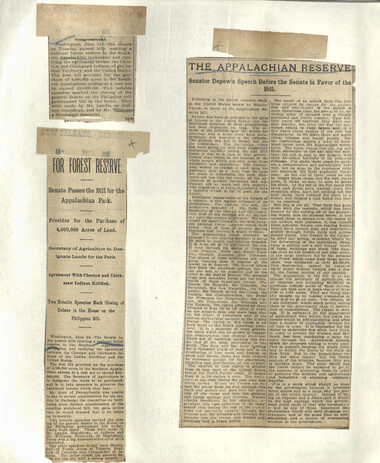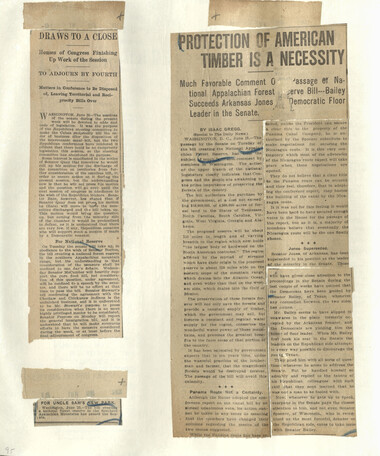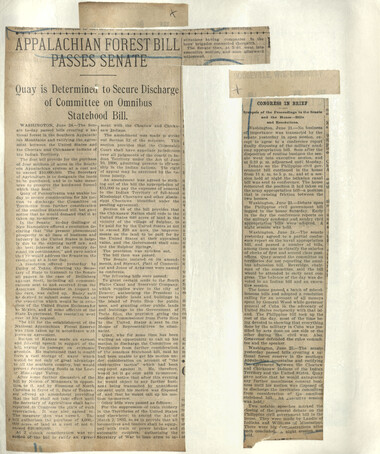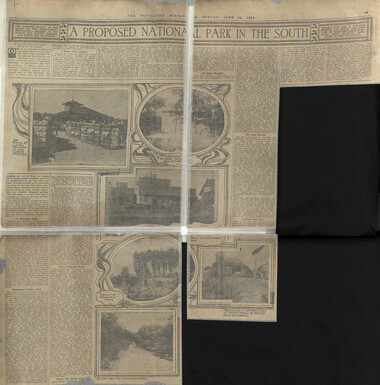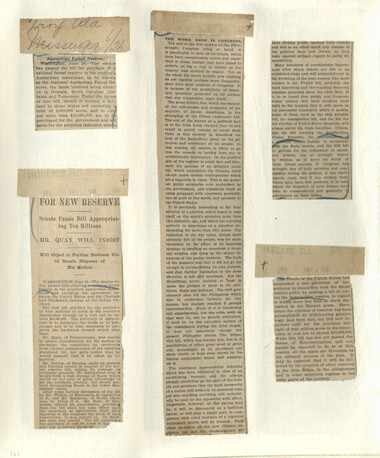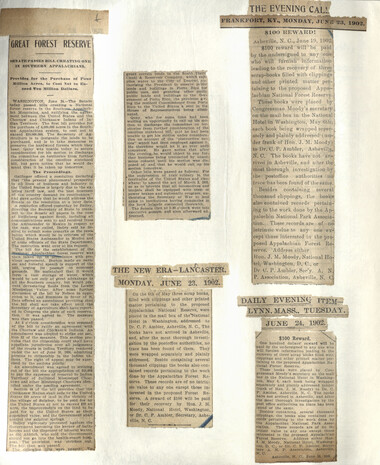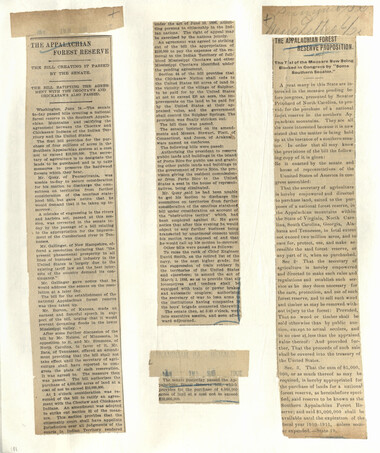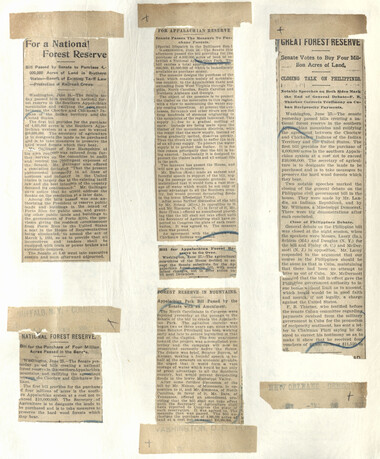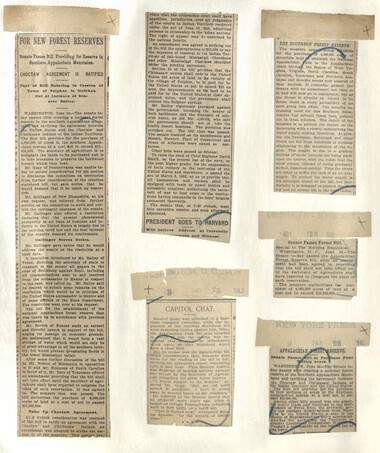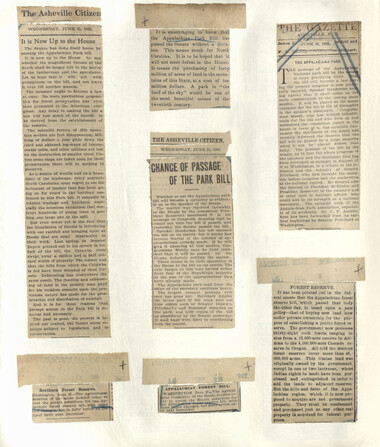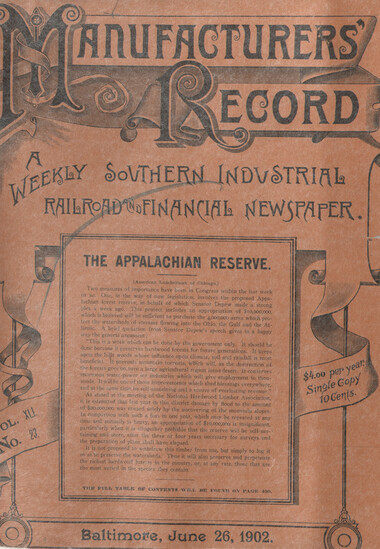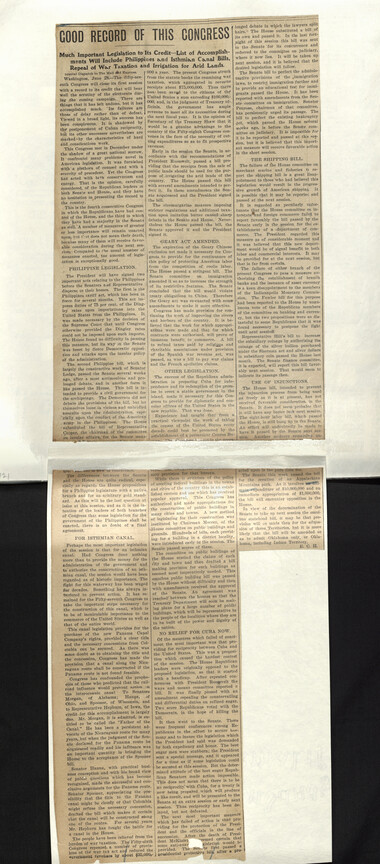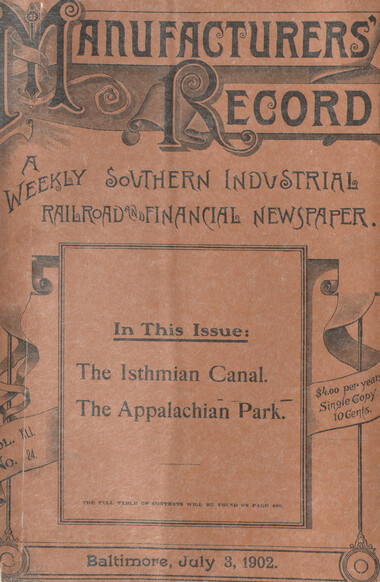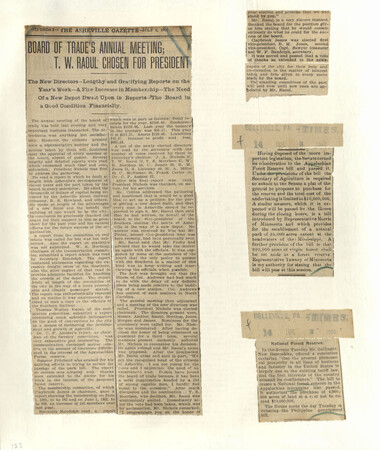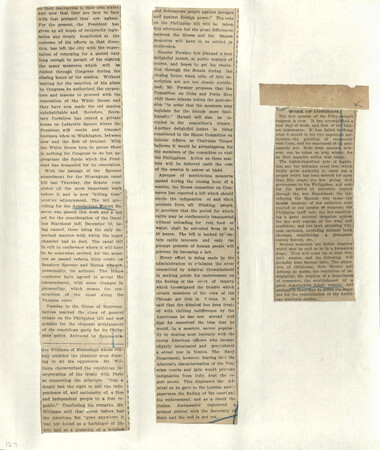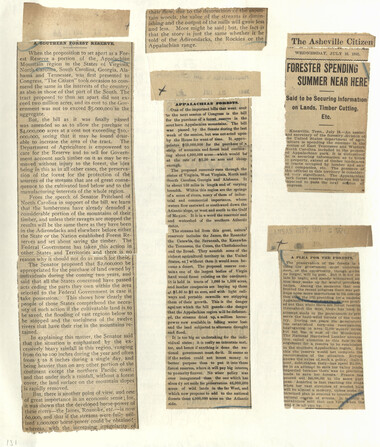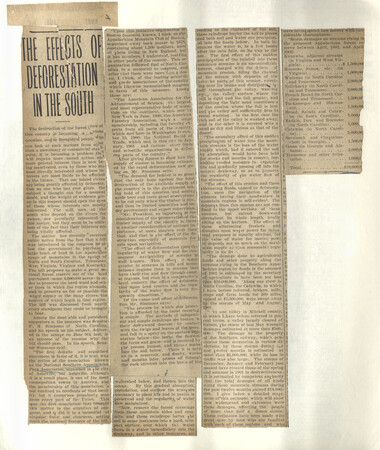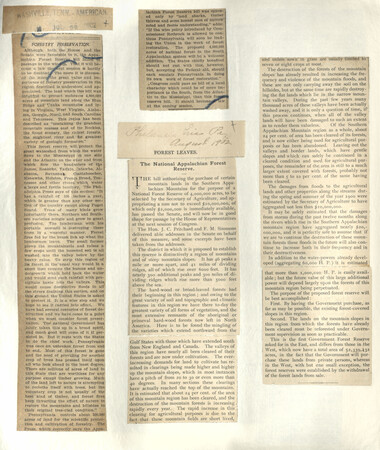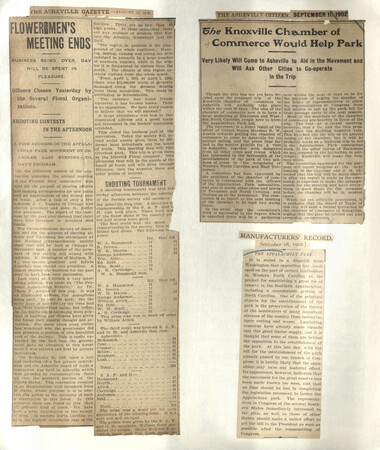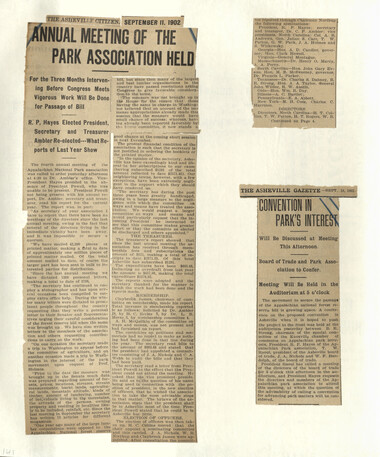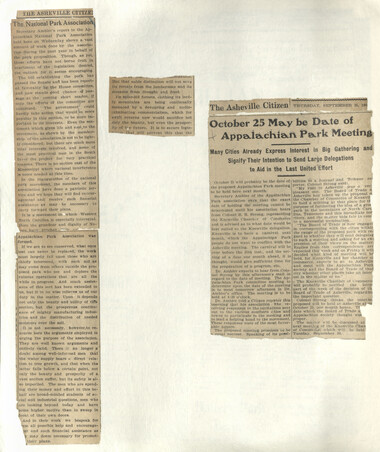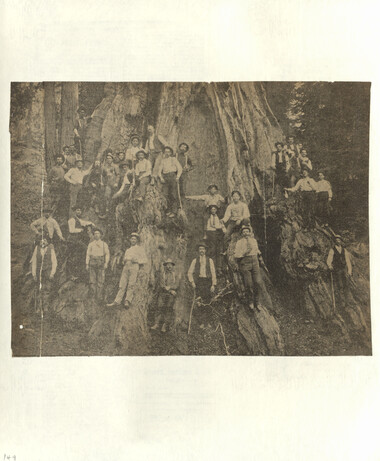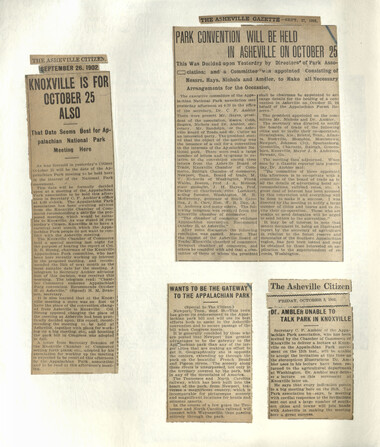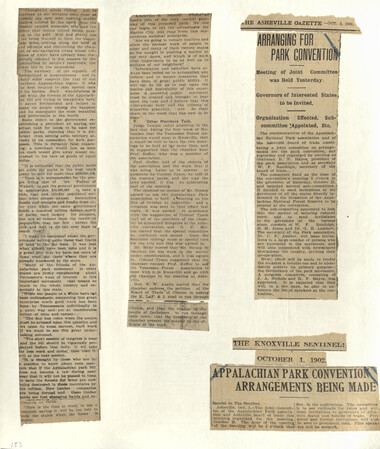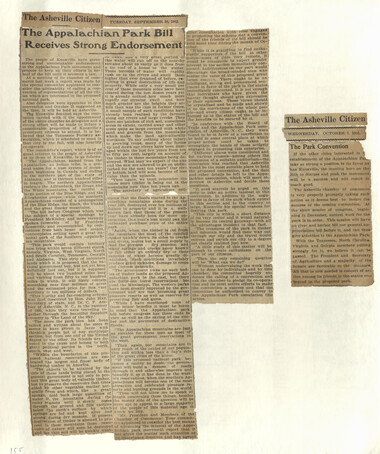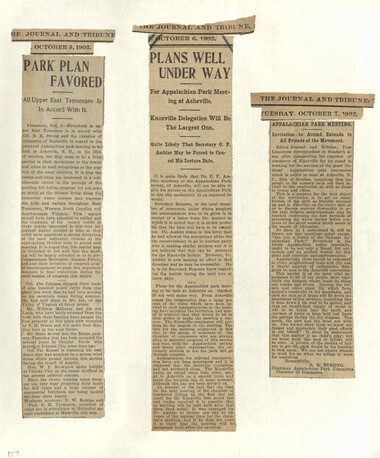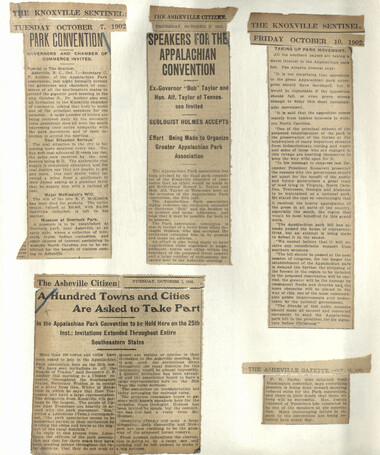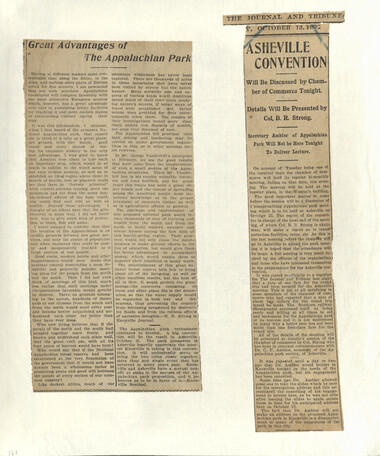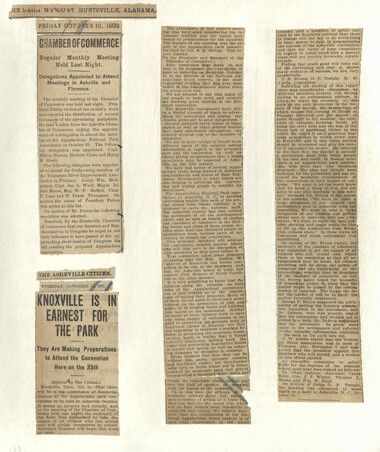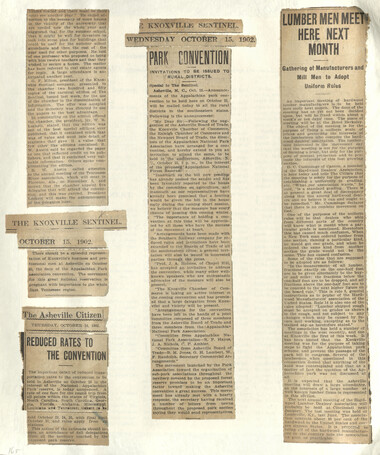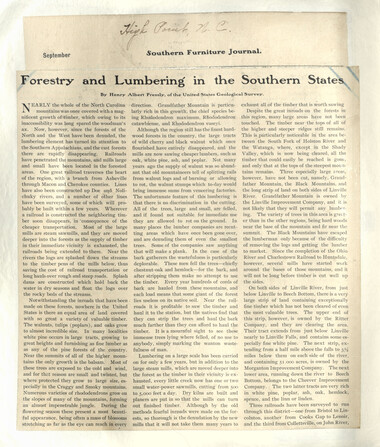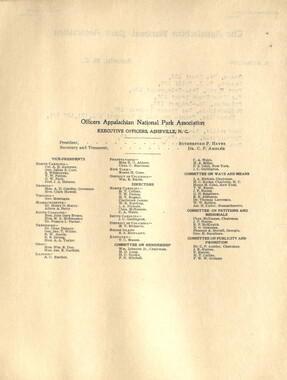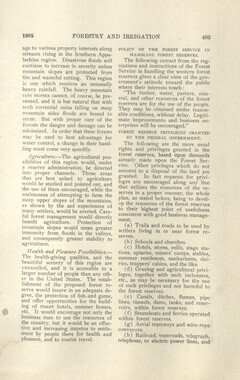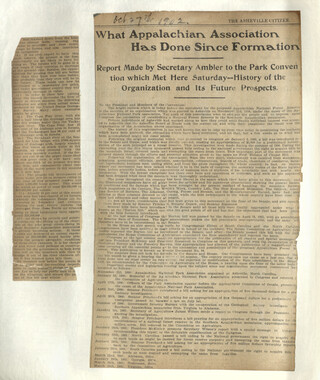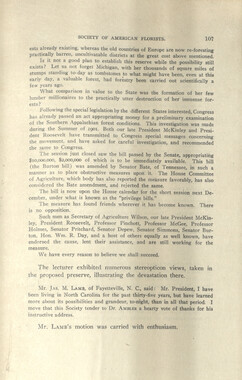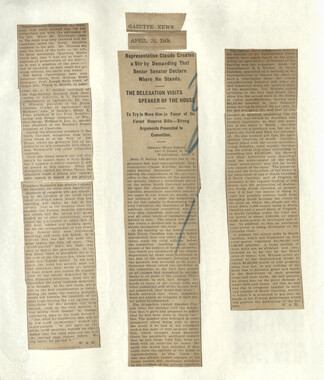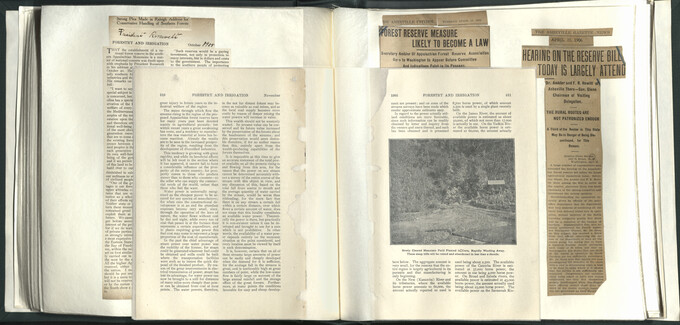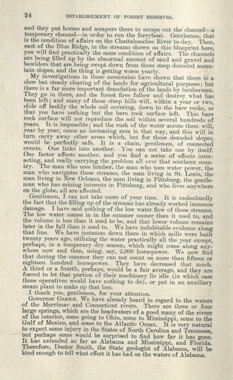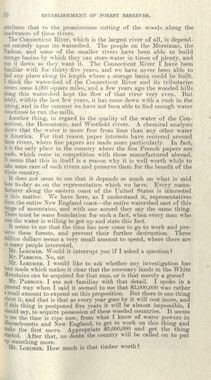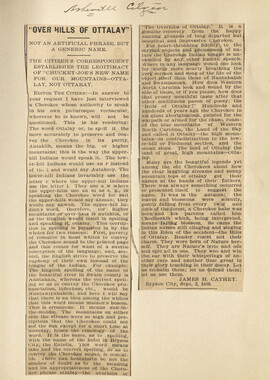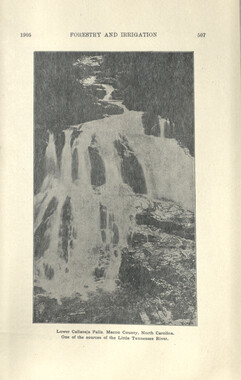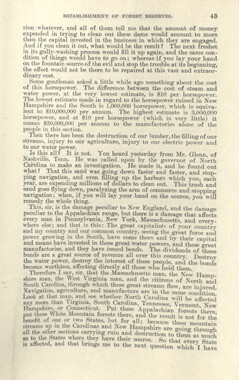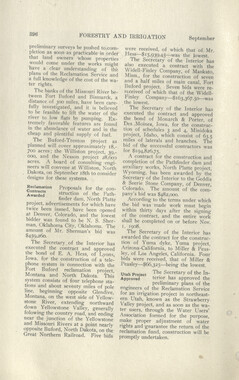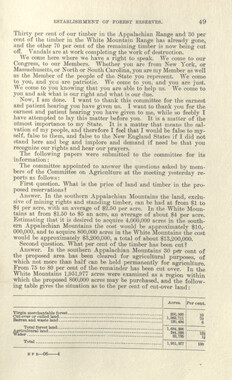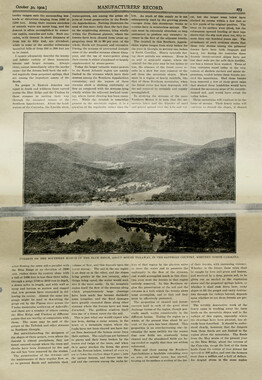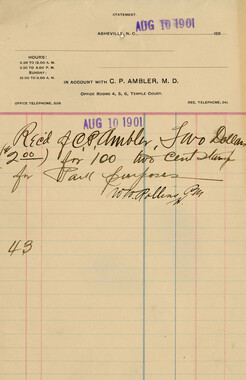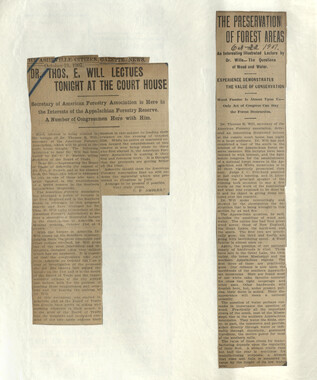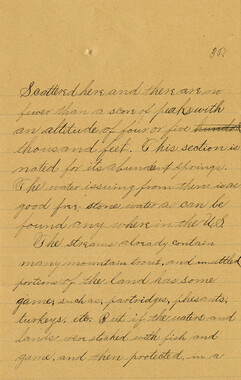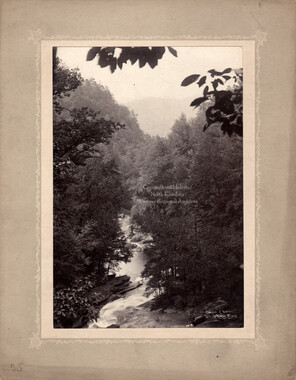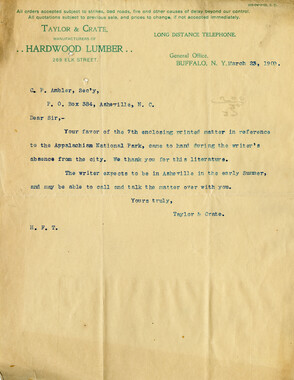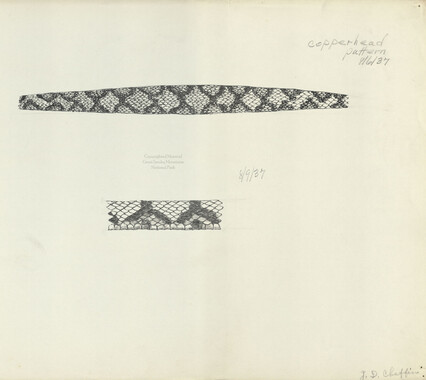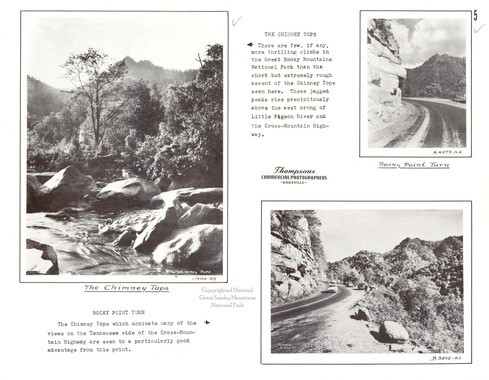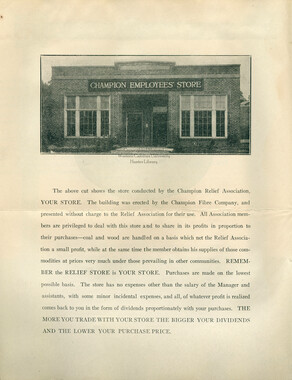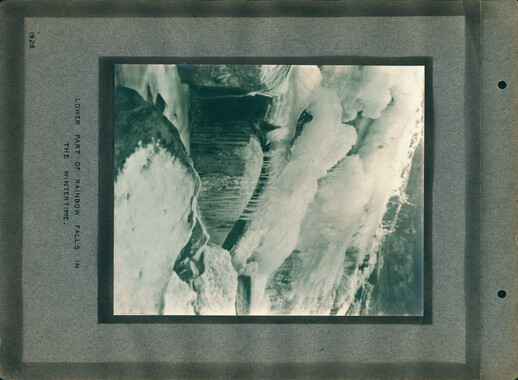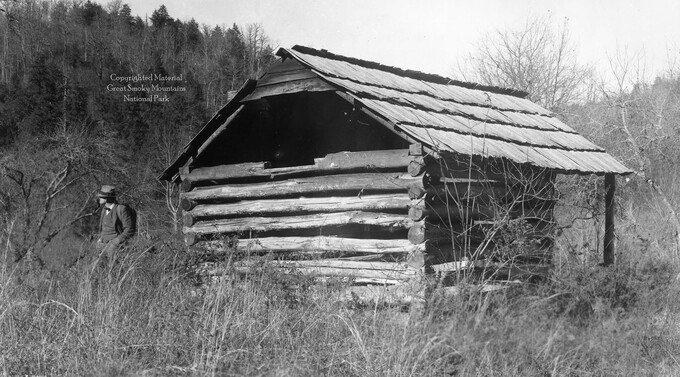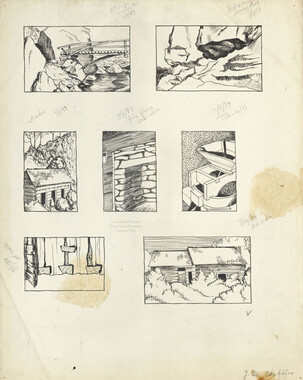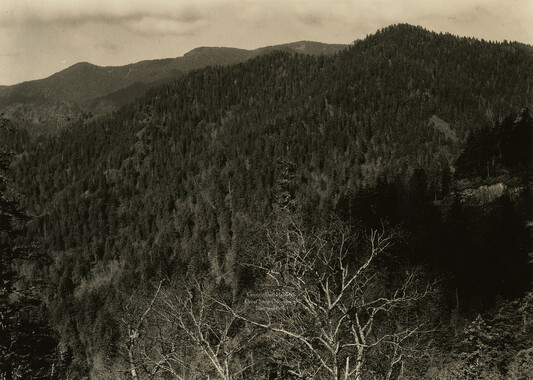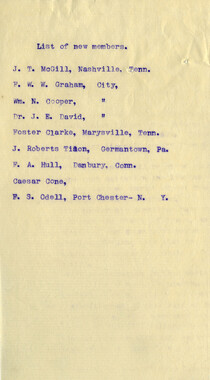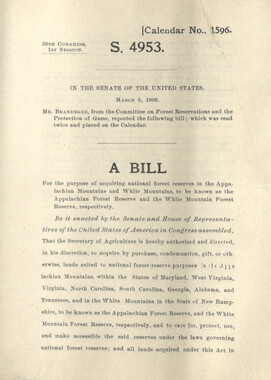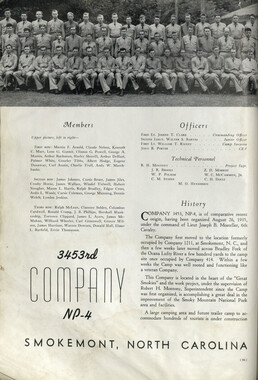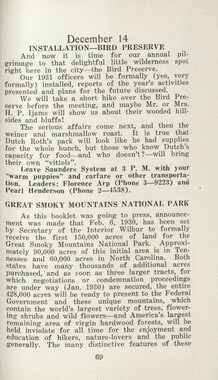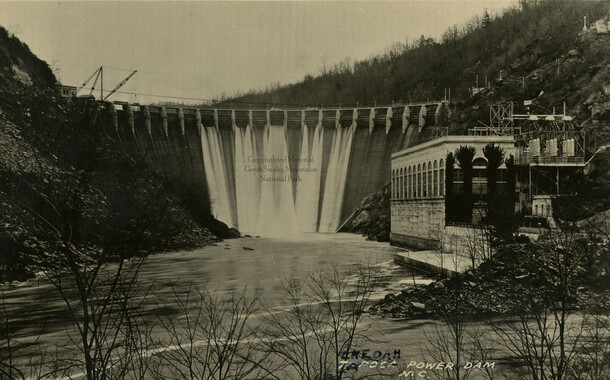Western Carolina University (20)
View all
- Canton Champion Fibre Company (2308)
- Cherokee Traditions (292)
- Civil War in Southern Appalachia (165)
- Craft Revival (1942)
- Great Smoky Mountains - A Park for America (2766)
- Highlights from Western Carolina University (430)
- Horace Kephart (941)
- Journeys Through Jackson (154)
- LGBTQIA+ Archive of Jackson County (85)
- Oral Histories of Western North Carolina (314)
- Picturing Appalachia (6772)
- Stories of Mountain Folk (413)
- Travel Western North Carolina (160)
- Western Carolina University Fine Art Museum Vitreograph Collection (129)
- Western Carolina University Herbarium (92)
- Western Carolina University: Making Memories (708)
- Western Carolina University Publications (2283)
- Western Carolina University Restricted Electronic Theses and Dissertations (146)
- Western North Carolina Regional Maps (71)
- World War II in Southern Appalachia (131)
University of North Carolina Asheville (6)
View all
- Allanstand Cottage Industries (62)
- Appalachian National Park Association (53)
- Bennett, Kelly, 1890-1974 (1388)
- Berry, Walter (76)
- Brasstown Carvers (40)
- Carver, George Washington, 1864?-1943 (26)
- Cathey, Joseph, 1803-1874 (1)
- Champion Fibre Company (233)
- Champion Paper and Fibre Company (297)
- Cherokee Indian Fair Association (16)
- Cherokee Language Program (22)
- Crowe, Amanda (40)
- Edmonston, Thomas Benton, 1842-1907 (7)
- Ensley, A. L. (Abraham Lincoln), 1865-1948 (275)
- Fromer, Irving Rhodes, 1913-1994 (70)
- George Butz (BFS 1907) (46)
- Goodrich, Frances Louisa (120)
- Grant, George Alexander, 1891-1964 (96)
- Heard, Marian Gladys (60)
- Kephart, Calvin, 1883-1969 (15)
- Kephart, Horace, 1862-1931 (313)
- Kephart, Laura, 1862-1954 (39)
- Laney, Gideon Thomas, 1889-1976 (439)
- Masa, George, 1881-1933 (61)
- McElhinney, William Julian, 1896-1953 (44)
- Niggli, Josephina, 1910-1983 (10)
- North Carolina Park Commission (105)
- Osborne, Kezia Stradley (9)
- Owens, Samuel Robert, 1918-1995 (11)
- Penland Weavers and Potters (36)
- Roberts, Vivienne (15)
- Roth, Albert, 1890-1974 (142)
- Schenck, Carl Alwin, 1868-1955 (1)
- Sherrill's Photography Studio (2565)
- Southern Highland Handicraft Guild (127)
- Southern Highlanders, Inc. (71)
- Stalcup, Jesse Bryson (46)
- Stearns, I. K. (213)
- Thompson, James Edward, 1880-1976 (226)
- United States. Indian Arts and Crafts Board (130)
- USFS (683)
- Vance, Zebulon Baird, 1830-1894 (1)
- Weaver, Zebulon, 1872-1948 (58)
- Western Carolina College (230)
- Western Carolina Teachers College (282)
- Western Carolina University (1794)
- Western Carolina University. Mountain Heritage Center (18)
- Whitman, Walt, 1819-1892 (10)
- Wilburn, Hiram Coleman, 1880-1967 (73)
- Williams, Isadora (3)
- Cain, Doreyl Ammons (0)
- Crittenden, Lorraine (0)
- Rhodes, Judy (0)
- Smith, Edward Clark (0)
- Appalachian Region, Southern (2569)
- Asheville (N.C.) (1923)
- Avery County (N.C.) (26)
- Blount County (Tenn.) (161)
- Buncombe County (N.C.) (1672)
- Cherokee County (N.C.) (283)
- Clay County (N.C.) (555)
- Graham County (N.C.) (233)
- Great Smoky Mountains National Park (N.C. and Tenn.) (519)
- Haywood County (N.C.) (3524)
- Henderson County (N.C.) (70)
- Jackson County (N.C.) (4694)
- Knox County (Tenn.) (25)
- Knoxville (Tenn.) (12)
- Lake Santeetlah (N.C.) (10)
- Macon County (N.C.) (420)
- Madison County (N.C.) (212)
- McDowell County (N.C.) (39)
- Mitchell County (N.C.) (132)
- Polk County (N.C.) (35)
- Qualla Boundary (981)
- Rutherford County (N.C.) (76)
- Swain County (N.C.) (2115)
- Transylvania County (N.C.) (270)
- Watauga County (N.C.) (12)
- Waynesville (N.C.) (84)
- Yancey County (N.C.) (72)
- Aerial Photographs (3)
- Aerial Views (60)
- Albums (books) (4)
- Articles (1)
- Artifacts (object Genre) (228)
- Bibliographies (1)
- Biography (general Genre) (2)
- Cards (information Artifacts) (38)
- Clippings (information Artifacts) (191)
- Crafts (art Genres) (622)
- Depictions (visual Works) (21)
- Design Drawings (1)
- Drawings (visual Works) (184)
- Envelopes (73)
- Facsimiles (reproductions) (1)
- Fiction (general Genre) (4)
- Financial Records (12)
- Fliers (printed Matter) (67)
- Glass Plate Negatives (381)
- Guidebooks (2)
- Internegatives (10)
- Interviews (815)
- Land Surveys (102)
- Letters (correspondence) (1013)
- Manuscripts (documents) (618)
- Maps (documents) (177)
- Memorandums (25)
- Minutes (administrative Records) (59)
- Negatives (photographs) (5835)
- Newsletters (1285)
- Newspapers (2)
- Occupation Currency (1)
- Paintings (visual Works) (1)
- Pen And Ink Drawings (1)
- Periodicals (193)
- Personal Narratives (10)
- Photographs (12976)
- Plans (maps) (1)
- Poetry (6)
- Portraits (4533)
- Postcards (329)
- Programs (documents) (151)
- Publications (documents) (2236)
- Questionnaires (65)
- Scrapbooks (282)
- Sheet Music (2)
- Slides (photographs) (402)
- Songs (musical Compositions) (2)
- Sound Recordings (796)
- Specimens (92)
- Speeches (documents) (15)
- Tintypes (photographs) (8)
- Transcripts (322)
- Video Recordings (physical Artifacts) (23)
- Vitreographs (129)
- Text Messages (0)
- A.L. Ensley Collection (275)
- Appalachian Industrial School Records (7)
- Appalachian National Park Association Records (336)
- Axley-Meroney Collection (2)
- Bayard Wootten Photograph Collection (20)
- Bethel Rural Community Organization Collection (7)
- Blumer Collection (5)
- C.W. Slagle Collection (20)
- Canton Area Historical Museum (2110)
- Carlos C. Campbell Collection (282)
- Cataloochee History Project (64)
- Cherokee Studies Collection (4)
- Daisy Dame Photograph Album (5)
- Daniel Boone VI Collection (1)
- Doris Ulmann Photograph Collection (112)
- Elizabeth H. Lasley Collection (1)
- Elizabeth Woolworth Szold Fleharty Collection (4)
- Frank Fry Collection (95)
- George Masa Collection (173)
- Gideon Laney Collection (452)
- Hazel Scarborough Collection (2)
- Hiram C. Wilburn Papers (28)
- Historic Photographs Collection (236)
- Horace Kephart Collection (861)
- Humbard Collection (33)
- Hunter and Weaver Families Collection (1)
- I. D. Blumenthal Collection (4)
- Isadora Williams Collection (4)
- Jesse Bryson Stalcup Collection (47)
- Jim Thompson Collection (224)
- John B. Battle Collection (7)
- John C. Campbell Folk School Records (80)
- John Parris Collection (6)
- Judaculla Rock project (2)
- Kelly Bennett Collection (1407)
- Love Family Papers (11)
- Major Wiley Parris Civil War Letters (3)
- Map Collection (12)
- McFee-Misemer Civil War Letters (34)
- Mountain Heritage Center Collection (4)
- Norburn - Robertson - Thomson Families Collection (44)
- Pauline Hood Collection (7)
- Pre-Guild Collection (2)
- Qualla Arts and Crafts Mutual Collection (12)
- R.A. Romanes Collection (681)
- Rosser H. Taylor Collection (1)
- Samuel Robert Owens Collection (94)
- Sara Madison Collection (144)
- Sherrill Studio Photo Collection (2558)
- Smoky Mountains Hiking Club Collection (616)
- Stories of Mountain Folk - Radio Programs (374)
- The Reporter, Western Carolina University (510)
- Venoy and Elizabeth Reed Collection (16)
- WCU Gender and Sexuality Oral History Project (32)
- WCU Mountain Heritage Center Oral Histories (25)
- WCU Oral History Collection - Mountain People, Mountain Lives (71)
- WCU Students Newspapers Collection (1744)
- Western North Carolina Tomorrow Black Oral History Project (69)
- William Williams Stringfield Collection (2)
- Zebulon Weaver Collection (109)
- African Americans (390)
- Appalachian Trail (35)
- Artisans (521)
- Cherokee art (84)
- Cherokee artists -- North Carolina (10)
- Cherokee language (21)
- Cherokee pottery (101)
- Cherokee women (208)
- Church buildings (170)
- Civilian Conservation Corps (U.S.) (110)
- College student newspapers and periodicals (1830)
- Dams (107)
- Dance (1023)
- Education (222)
- Floods (61)
- Folk music (1015)
- Forced removal, 1813-1903 (2)
- Forest conservation (220)
- Forests and forestry (1184)
- Gender nonconformity (4)
- Great Smoky Mountains National Park (N.C. and Tenn.) (181)
- Hunting (38)
- Landscape photography (25)
- Logging (118)
- Maps (83)
- Mines and mineral resources (8)
- North Carolina -- Maps (18)
- Paper industry (38)
- Postcards (255)
- Pottery (135)
- Railroad trains (71)
- Rural electrification -- North Carolina, Western (3)
- School integration -- Southern States (2)
- Segregation -- North Carolina, Western (5)
- Slavery (5)
- Sports (452)
- Storytelling (244)
- Waterfalls -- Great Smoky Mountains (N.C. and Tenn.) (66)
- Weaving -- Appalachian Region, Southern (280)
- Wood-carving -- Appalachian Region, Southern (328)
- World War, 1939-1945 (173)
Appalachian National Park Association Newspaper Clippings, 1899-1902
Item
Item’s are ‘child’ level descriptions to ‘parent’ objects, (e.g. one page of a whole book).
-
-
The Asheville Citizen I JCfsaifc^fca i ^fcat^ffcfr t^fcat^ffcat^fcat^B^A^f^^j^f^^^^f^^ t tWkMhM*ima ^ls^TT^i^^" ^^^t^^^^ ^^r^T^^r^T ^^^Ti^r»T ^^^^T •jp^^T^p^Wr ^^^T^j^' National Park a.nd I Forest Reservation | ikrini^iifti.^ii^ii^iittiiiMiii o.i^11ifc..iii . ■ In the May number of "Country Life in America," the leading article is contributed by Dr. C. P. Ambler of this city, who writes on "Our Mountain Forests—their value and the need of preserving them," Dr. Ambler's paper is handsomely 11- jlustrated with one full page and four smaller pictures. The full page picture represents "a scene in the Southern Appalachians—on the French Broad river." The others are: "Mt. Pisgah from Vai . irbllt hunting lodge," "A Wild -.f. wooded North Carolina mountain stream," "View from Dodson's cabin, Hickory Nut Gap," and "A mountain home." Touching the necessity for forest preservation and establishment of the proposed Appalachian National Park, Dr. Ambler writes: "From the time of the earliest settlement in America up to the middle ot tiie eighteenth century the destruction of fort-sis and the clearing of lands for cultivation constituted one of the greatest improvements of our country. Every KG.! invited the settler who would lev, out a claim; the work was looked upon and really considered as one of the greatest importance; each coming gen- eratlon was born with the idea to destroy the woodland, to claim it for cultivation, and as long as our millions of. square miles were covered with forests, Our forefathers never thought of a tirfle to come win would cease to ex ist. The} changes to be brought about, ol streams which would by this destruction become dry; they figured but littt ninl value of lumber to comb 11 Ions, ami even il they had il would have made no difference, the ' i have gone on i it was necessary, it was right, and those hardy pioneers are deserving of the greatest praise for what they did; we owe our couiitry today to them. "Since those early times we treated our forests as if they were inexhaustible. There is nothing remarkable in this fact, however, as we have put ni" policy toward i form of natural wealth. We have been living like spendthrifts in the time ot plenty. We have destroyed our game; only in recent years have we begun to realize that our supply of (lsh is ex» haustible. Our oysters were threatened with extinction. One of the great aims of the civilized race should be to use the resources which have been received from nature so that they can be handed down to posterity undiminished in value and improved for our successors. "The shifting and eve-increasing sand-banks which now cover thousands of acres along the shore, especially at ■ Cod, owe their presence and their extension to the carelessness ana thoughtlessness of man. This sand des- ort of the coast of our country is not natural, but was created by human en ergy; by man's greed and man's thoughtlessness thousands of acres of coast lands have been rendered valueless and the shifting sands are ever extending farther inland. Great sums of money have been expended in the effort to stay this sea of sand, but little has been accomplished except to demonstrate the futility of the methods employed. "Can we not profit by the experience of older countries? Should we not today realize that in a few years we will be exactly where they are today? "We annually appropriate large sums to dredge our river harbors. Of what? Of the wash that has come down from •the uplands—wash which in great part would never have occurred but for the unscientific handling of the forest lands at the headwaters of these rivers. "We dredge, too, because the waters of our harbors are failing. Will this failure diminish under the present proceeding? If it costs us today so many millions a year for river harbor dredging, what will it cost us a hundred years hence? Science tells us that we would better spend these millions In protecting our headwaters from deforestation today, and the effect of money eo spent will not be only lasting, but will earn interest. When we pour this money into our river harbors we pour it into the sea; it helps temporarily and is then gone forever. "The people of our mountain sections cannot be made to realize the gravity of a mountain fire. Many of these fires are started purposely, with an idea of producing grazing lands for cattle. In many instances forest fires traveling over the ground rapidly, simply burning the dried leaves, weeds and small underbrush, will bring about a condition In which temporarily better grazing may be had, but this is only the result when the fire runs over the ground the first time. If this land is fired again and again, each succeeding fire burns deeper into the ground, destroys more of the root mass, and, as a rule, after two or three fires the soil 11 begin to wash. There are almost no forests In the states today where one would be justified in starting a .forest fire. "Scientific forestry has, during the past five years, attracted the attention of the Government as well as the capitalist. We today have four schools of ] forestry. The Government owns thirty- six forest reserves aggregating 46,500,- .)"" .ii-i-e.:. :Hunted without exception In tin- extreme Northwest. Different states are establishing forest reserves where the same is practical. Many - wealthy citizens have made investments in foi'esl lands with an idea of practicing scientific lumbering, Our [Government Forestry Bureau is doing a greal ami rapidly growing work; the [trend of the tinn- Is bow to save—to pri.te. ■ .,i io destroy. ■■The I I'ei. whlCil a few .V ■..ii. Id I,.i financial iralue Is today, if let alone a rid simply protected. i ..'. . miie. ;i fa i. rale of inleresl nn the >■ or tin- land upon which th stands. Lumber has Increased in, 20 r cent, in value during the panf few years; it will Increase even n during the next few years to einne. A (mature tree should always be cut—cut, however, with. . .ing the young b . mi,ninl it. Any product "i tin- soil should be prob while growing, cut when ripe; It never to the value of Itself or Its Ml If allowed to fall. "The destruction of the mountain forests of this country is of such far- reaching effect that it he to be .-> state question. No state would ti be justified In establishing a forest rc- .1 million acnes, Coi reason that the benefits which would be derived from this reserve would accure more to the surrounding mi^to' the state wherein the I as Tks- tabllshed. Pennsylvania .-, .uld, of se, be ph. ee New YorSy blished a forest reserve, like- ■ would New York like to see Pennsylvania do the same. This holds true of any neighboring states; the forests of the mountains are necessary to the ag-- i-ii-ultural districts lying in the lowlands on of the rainfall. It is coming to a point In the Kast where the national government itself will have to step in and establish reserves at the most feasible points. The states will their consent (North Carolina, li Carolina, Georgia, Tennessee and Virginia have already done so), but these states cannot be expected to pay those who now own the lands privately. "Nowhere on this continent can there be found today as large areas of virgin sts as thers are in the southern Appalachians, and nowhere are the forests composed of so large a variety of hardwood trees. This is a point where the flora of the North and South practically meet—where all species found in the North, as well as the South, grow in profusion, according to the altitude and the natural environment. Here the hemlock reaches its greatest growth; the pine, the oak, the ash, poplar, flip, cherry, walnut, chestnut and many i.ther kinds of trees grow to a size which can be found nowhere else in the country. True, the difficulty of marketing u. ,'ier from these steep mountain slopes is enormous, but the price of lumber is soaring. Indeed, the inroads of unscientific lumbermen in this region have already become alarming. "These mountains are sure for generations to come to be the playground of the whole South and southeastern section. As has already been shown, the mountains are as a reservoir for the rivers of the whole southeastern states. The agricultural districts of these states are all more or less dependent upon these mountains for their water supply. The South is awaking to its possibilities as a manufacturing center. Thousands of water power plants are being installed whose future must be looked to. "The natural scenery of the section under consideration is also one which ha3 attracted national attention. Climate and scenery combine to in. a famous winter resort for northerners and summer resort for southerners. Here are the most beautiful as well as the highest mountains east , of the Rockies (Mt. Mitchell 6,710 ft.); more than forty moutains having an elevation of 6000 feet are here found, all covered with virgin forests. The II- Buch as to attract the attention of botanists all over the country; here are cliffs, waterfalls, gorges, cascades, valleys, ridges, knolls and peaks abouil- Ing In every direction, and we should certainly see that at least a portion of this beauty is handed down to posterity. "The existing national parks can be visited only in summer. If a n park or forest reserve were established in this country it could, with pi and comfort, be visited the year round. The location is central, being only twenty-four hours' ride froi York, Chicago, St. Louis and the Gulf states, ii Is, therefore, within reach of the masses oi , and while these parks B ml . l i ' .'i.l.v est.':! ■ Vellnw :;|... far from the centers of i. that none in the Blast bill th and tlmse ii.i viiii; plenty of time ford or hope l" visit the Bam short : eason of i he fsilowstone, I er with the high price of all foodstuffs (which cannot be raised In th ntry) makes it Imperative that exi rales be i iltlng this rej erve. in the A p. is, the tourist of the most mode would find living no higher than at hop belli- ' i.nint with the masses when -ing an outing. "The Government can easllj large part of this most beautiful and attractive country, as the same is held in large tracts by corporations^ estates ai thy Individuals. For this reason it would be working no hardship on any one if a large section of this Appalachian mountain region should be appropriated for the purposes mentioned. The lands could be bought at an average price of from two to five dollars per acre. "For many years there has been talk of the Government acquiring control of a portion of the Appalachian country. Dr. Henry O. Marcy, of Boston, in a paper on Climatology, read before the Academy of Medicine, October 25, 1885, was one of the first to write in favor of this movement. It -was not. ho until November 22, 1899, that any systematic effort was made to bring the attention of the Government to the matter. During the summer of 1893 private citizens of Asheville, N. C, started a movement which resulted In a well-formed and chartered oi^anizatlon ed "The Appalachian National Park Association," with the aim of securing a national park and forest reserve in the southern Appalachian mountains. The territory which it is proposed thus to purchase and include in the l serve lies in western North Carolina, eastern Tennessee, Virginia, northern Georgia, - land northern South Carloina, embrac- , \ ing an area of approximately 2,000,000 .acres, the territory thus included cover-i ; ing about ten miles of country on each .side of the North Carolina-Tennessee (state line. The original memorial pre-
Object
Object’s are ‘parent’ level descriptions to ‘children’ items, (e.g. a book with pages).
-
This is one of two notebooks assembled by the Appalachian National Park Association that includes documents and news clipping about the organization. The Appalachian National Park Association was formed in 1899 for the purpose of promoting the idea of a national park in the eastern U.S. Although housed in Asheville, North Carolina, the organization was a multi-state effort, attracting representatives from seven southern states. One of the highlights of the group’s activities was a convention held in 1902 to which 1,500 people attended. The association lobbied Congress for the creation of a park, but with limited success. The association disbanded in 1905.
-



